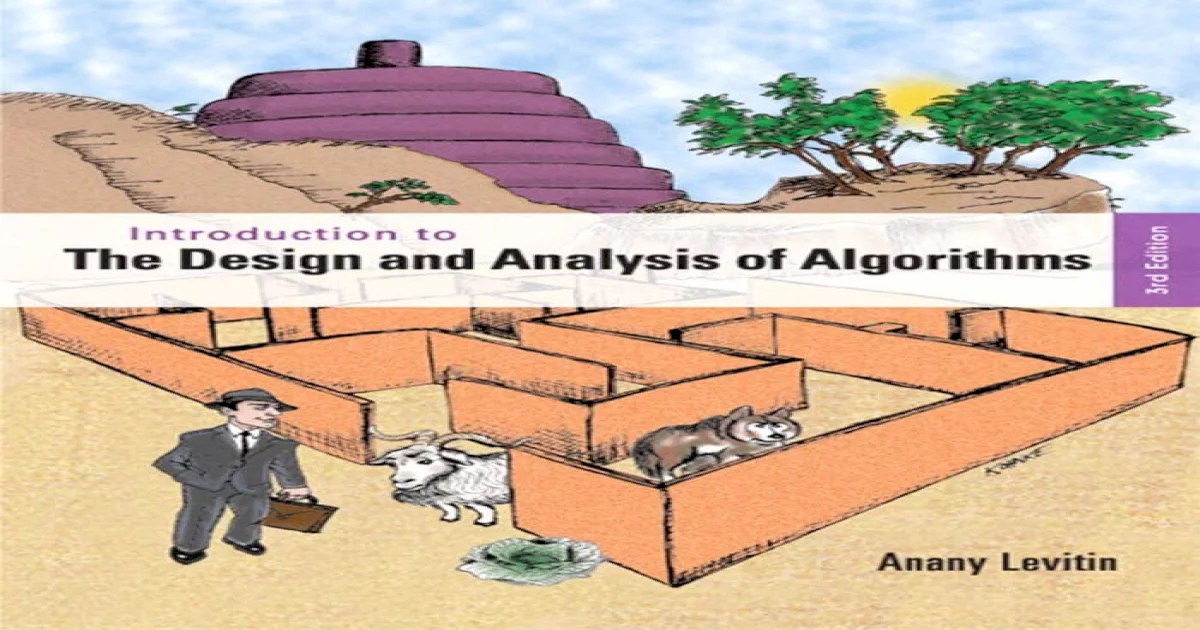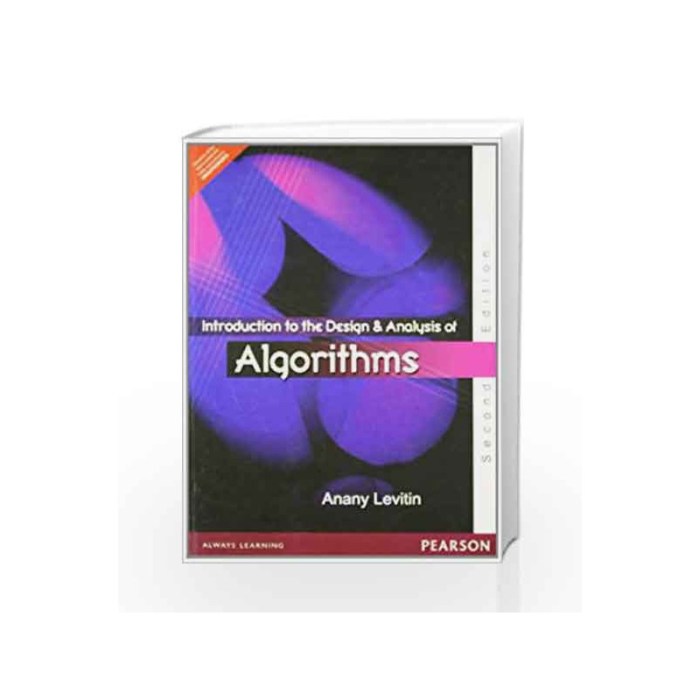Introduction to design and analysis of algorithms 3rd edition – The third edition of Introduction to Design and Analysis of Algorithms, a seminal work in the field of computer science, offers a comprehensive and authoritative exploration of the fundamental concepts, techniques, and applications of algorithm design and analysis. This revised edition has been meticulously updated to reflect the latest advancements in the field, ensuring that readers gain a thorough understanding of the intricacies of algorithm design and its profound impact on modern computing.
This seminal work delves into the essential concepts of algorithms, their diverse applications, and the challenges and opportunities inherent in designing efficient algorithms. It provides a systematic and rigorous approach to algorithm analysis, equipping readers with the tools to evaluate the performance of algorithms and make informed decisions about their selection and implementation.
Furthermore, the book explores advanced design techniques, case studies, and emerging trends in algorithm research, empowering readers to stay at the forefront of this rapidly evolving field.
1. Introduction to Algorithms: Introduction To Design And Analysis Of Algorithms 3rd Edition

Algorithms are precise sequences of instructions that computers follow to perform specific tasks. They play a crucial role in computer science, providing the foundation for solving complex problems and designing efficient software systems.
Algorithms come in various types, including sequential, iterative, and recursive algorithms. Each type has its advantages and applications, ranging from sorting and searching to optimization and artificial intelligence.
Designing efficient algorithms is a challenging yet rewarding endeavor. It requires a deep understanding of algorithm design techniques and the ability to analyze algorithm performance under different scenarios.
1.1 Different Types of Algorithms
- Sequential algorithms execute instructions in a linear order.
- Iterative algorithms repeat a set of instructions until a specific condition is met.
- Recursive algorithms solve problems by repeatedly breaking them down into smaller subproblems.
1.2 Applications of Algorithms
- Sorting: Algorithms like quicksort and mergesort efficiently arrange data in ascending or descending order.
- Searching: Algorithms like binary search and hash tables quickly locate specific elements within large datasets.
- Optimization: Algorithms like linear programming and genetic algorithms find optimal solutions to complex problems.
- Artificial Intelligence: Algorithms like neural networks and decision trees power machine learning and other AI applications.
2. Algorithm Analysis

Algorithm analysis is essential for understanding algorithm performance and making informed design decisions. It involves evaluating algorithms based on their time and space complexity.
Time complexity measures the amount of time an algorithm takes to execute, typically expressed using asymptotic notation like O(n) or O(n^2). Space complexity measures the amount of memory an algorithm requires, also expressed using asymptotic notation.
Different analysis techniques exist, including theoretical analysis, empirical analysis, and simulation. Each technique has its advantages and disadvantages, and the choice depends on the specific algorithm and context.
2.1 Importance of Algorithm Analysis
- Predicting algorithm performance under different scenarios.
- Comparing different algorithms for a given problem.
- Guiding algorithm design and optimization.
2.2 Methods for Analyzing Algorithms
- Theoretical analysis uses mathematical techniques to derive worst-case, best-case, and average-case complexity.
- Empirical analysis involves running the algorithm on specific inputs and measuring its performance.
- Simulation models the algorithm’s execution to estimate its performance under different conditions.
3. Design Techniques

Designing efficient algorithms requires a systematic approach and a deep understanding of different design techniques.
Common design techniques include divide-and-conquer, greedy algorithms, dynamic programming, and backtracking. Each technique has its advantages and is suitable for specific types of problems.
Divide-and-conquer algorithms break down a problem into smaller subproblems, solve each subproblem recursively, and combine the solutions. Greedy algorithms make locally optimal choices at each step, aiming for a globally optimal solution. Dynamic programming solves problems by storing solutions to subproblems and reusing them to avoid redundant calculations.
Backtracking algorithms explore all possible solutions systematically, looking for a valid or optimal solution.
3.1 Divide-and-Conquer Algorithms, Introduction to design and analysis of algorithms 3rd edition
- Suitable for problems that can be divided into independent subproblems.
- Examples: Merge sort, quicksort, binary search.
3.2 Greedy Algorithms
- Make locally optimal choices at each step.
- Examples: Dijkstra’s algorithm for shortest path, Kruskal’s algorithm for minimum spanning tree.
Query Resolution
What are the key features of the third edition of Introduction to Design and Analysis of Algorithms?
The third edition of Introduction to Design and Analysis of Algorithms has been extensively revised and updated to include the latest advancements in the field. It features new chapters on advanced data structures, randomized algorithms, and approximation algorithms, as well as expanded coverage of topics such as dynamic programming and graph algorithms.
Who is the target audience for this book?
Introduction to Design and Analysis of Algorithms, 3rd Edition, is intended for undergraduate and graduate students in computer science, as well as researchers and practitioners in the field. It assumes a basic understanding of data structures and algorithms, and provides a comprehensive foundation for further study in algorithm design and analysis.
What are the benefits of using this book?
Introduction to Design and Analysis of Algorithms, 3rd Edition, provides a rigorous and systematic approach to algorithm design and analysis. It equips readers with the tools and techniques necessary to design efficient algorithms, analyze their performance, and make informed decisions about their implementation.
The book also includes numerous exercises and examples to reinforce the concepts presented.